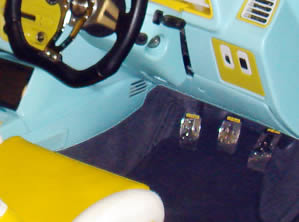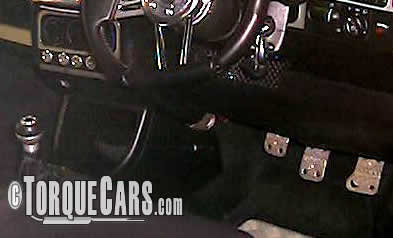How to Double DeClutch
"Master de clutch"
Double de-clutch (or double clutching):-
 The double de-clutch is best performed using the left pedal!
The double de-clutch is best performed using the left pedal!
To change gear you depress the clutch, move into neutral, release the clutch match engine speed, depress the clutch and engage the next gear.
So how does this method work and is it better than a single clutch gear change on a modern car fitted with a synchromesh?
For example on the up change 1st Gear to 2nd gear - Clutch down gear to neutral, clutch up still in neutral - set throttle to match transmission speed to engine rpm which is a little lower that before when changing up, clutch down then select second gear.
As the transmission speed will automatically drop a double de-clutch on up changes are not usually bothered with although on cars with lightened flywheels a double de-clutch still has merit as the engine revs will dip quickly and may need to be increased. It really depends on the engine and the amount of revs involved at the time of the up change.
Double de clutching comes into its own on down changes. Going down a gear is much the same double dip of the clutch method outlined above but you need to increase the engine speed. Some drivers will blip the throttle with their heel while braking with their toe to achieve this, particularly down changing on a track coming into a corner.
Try this with a standard single clutch gear change first matching the engine speed with the new gear speed with the clutch depressed, when you have mastered this start to practise the full double de clutch moving the gearbox into neutral.
I had to chuckle at one site which recommended practising a double declutch in a stationary car with the engine switched off which kind of defeats the whole object of matching the engine speed with the next selected gear speed.
When you get good this method takes as little time as a conventional gear change and maintains very smooth and progressive power delivery essential on track days or even in icy or slippery conditions. Other gear change techniques including keeping the foot to the floor during the gear change (power change).
Popping the gear out without using the clutch and dipping the clutch as the next gear is selected (lazy) - but handy if your clutch is on its way out and in higher gears if you are careful at matching the revs you can slip into the next gear without using the clutch at all, a skill I mastered on a 300 mile drive with a failed clutch.
Finally the method most drivers do or get into the habit of doing, depressing the clutch, changing gear and using the cars synchromesh to match the engine speed to gear speed. (Grannie shift)
 On modern cars with synchromesh some people argue that the DDC is no longer of value and others say that it is what proper drivers on a track do. Some maintain that it is only of value on down changes in the heel and toe method, but as with most driving techniques it depends on driver preference, car type and driving conditions.
On modern cars with synchromesh some people argue that the DDC is no longer of value and others say that it is what proper drivers on a track do. Some maintain that it is only of value on down changes in the heel and toe method, but as with most driving techniques it depends on driver preference, car type and driving conditions.
Why do it - its much smoother - when cornering at 100+ on a track a typical rough gear change could upset the balance of a car. It keeps the engine revs up on down changes so on a tight bend you do not lose traction or power and the engine is already pulling in the next gear through the apex of the bend.
On a drag strip where you just want to get the car to the top speed then the power change has a place but you still risk wheel spin and loss of traction with this brutal method.
I'm just really interested in the overall debate as to whether this method still has value today in the modern car. I feel that it does on the track, and if learned properly can keep the car in good working order and it is a habit you can master on the open road. Please join us in the forum to discuss this topic further.
If you liked this page please share it with your friends, drop a link to it in your favourite forum or use the bookmarking options to save it to your social media profile.
Check out TorqueCars new YouTube channel, and see their awesome new content...
Feedback
Please use our forums if you wish to ask a tuning question, and please note we do not sell parts or services, we are just an online magazine.
Help us improve, leave a suggestion or tip
